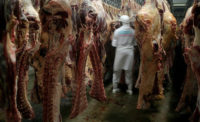Regulations & Legislation
COOL repealed for beef, pork: Now what?

On Dec. 18, 2015, Congress repealed the country of origin labeling (COOL) requirements for muscle cuts of beef and pork, and ground beef and pork. The repeal was in response to a World Trade Organization (WTO) ruling that found these COOL requirements discriminated against meat imports and that Canada and Mexico could impose retaliatory import tariffs against the United States.
In order to comply with the existing COOL regulation, retailers have been required to provide information to customers regarding the source of certain covered commodities, including muscle cuts and ground beef and pork, as well as muscle cuts and ground chicken, lamb and goat. The information regarding muscle cuts of covered commodities has included the production steps of birth, raising and slaughter of the animal from which the meat was derived, for each country listed in the origin designation. Commingling of muscle cut covered commodities from different origins has been prohibited.
Immediately after these requirements were repealed with respect to beef and pork, the U.S. Department of Agriculture (USDA) announced it would no longer enforce the COOL requirements for these products and it would work expeditiously to amend the COOL regulation. Questions, however, have arisen as to what requirements now apply to beef and pork products labeled with country of origin or other geographical claims and how will they be enforced.
FSIS guidance
On Dec. 21, 2015, the USDA’s Food Safety and Inspection Service (FSIS) issued a notice to advise inspection personnel the agency is working on guidance for federally inspected establishments related to geographic claims they may wish to make on beef and pork products now that COOL has been repealed. Until that guidance is issued, inspection personnel are not to take any independent action related to “claims conveying that beef or pork products have been produced or processed in the United States or have been derived from animals born and harvested in the U.S. or any other country mentioned in the statement.” We understand this instruction to not take action includes not verifying that federally inspected establishments have documentation to support geographical claims made on labels of beef and pork.
While FSIS considers new guidance regarding geographical claims, it is our understanding that establishments may continue to follow existing FSIS policy with respect to such claims. For example, pursuant to the current FSIS Standards and Labeling Policy Book, a “Product of the USA” claim is permitted on muscle cuts and ground beef and pork as long as the product is processed in the U.S. It would not matter that the animal used to produce the product was born and raised in another country. FSIS has applied this policy to turkey products, which have never been covered by COOL, and we understand FSIS would apply this policy to beef and pork, at least until new guidance is issued or the policy is changed. Should FSIS change this policy as it evaluates this matter further, we understand establishments would be granted sufficient time to comply.
With respect other geographic claims not covered by an existing FSIS policy or regulation (e.g., “Born and Raised in Canada, Slaughtered in the U.S.”), it would be prudent for establishments to continue to ensure they have documentation to support any claims made. NP
Looking for a reprint of this article?
From high-res PDFs to custom plaques, order your copy today!






